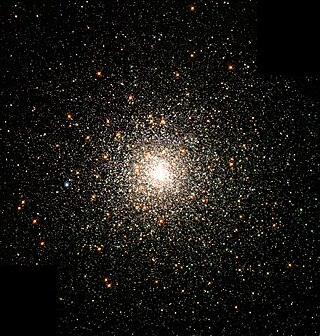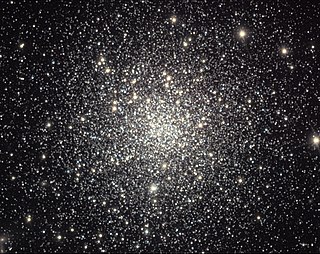
Messier 14 is a globular cluster of stars in the constellation Ophiuchus. It was discovered by Charles Messier in 1764.

Messier 5 or M5 is a globular cluster in the constellation Serpens. It was discovered by Gottfried Kirch in 1702.

Messier 107 or M107, also known as NGC 6171 or the Crucifix Cluster, is a very loose globular cluster in a very mildly southern part of the sky close to the equator in Ophiuchus, and is the last such object in the Messier Catalogue.

Messier 3 is a globular cluster of stars in the northern constellation of Canes Venatici.

Messier 72 is a globular cluster in the south west of the very mildly southern constellation of Aquarius.

Messier 2 or M2 is a globular cluster in the constellation Aquarius, five degrees north of the star Beta Aquarii. It was discovered by Jean-Dominique Maraldi in 1746, and is one of the largest known globular clusters.

Messier 80 is a globular cluster in the constellation Scorpius. It was discovered by Charles Messier in 1781, being one of his first discoveries.

Messier 10 or M10 is a globular cluster of stars in the equatorial constellation of Ophiuchus. The object was discovered by the French astronomer Charles Messier on May 29, 1764, who cataloged it as number 10 in his catalogue and described it as a "nebula without stars". In 1774, German astronomer Johann Elert Bode likewise called it a "nebulous patch without stars; very pale". Using larger instrumentation, German-born astronomer William Herschel was able to resolve the cluster into its individual members. He described it as a "beautiful cluster of extremely compressed stars". William Parsons, 3rd Earl of Rosse thought he could distinguish a dark lane through part of the cluster. The first to estimate the distance to the cluster was Harlow Shapley, although his derivation of 33,000 light years was much further than the modern value.

Messier 12 or M 12 is a globular cluster in the constellation of Ophiuchus. It was discovered by the French astronomer Charles Messier on May 30, 1764, who described it as a "nebula without stars". In dark conditions this cluster can be faintly seen with a pair of binoculars. Resolving the stellar components requires a telescope with an aperture of 8 in (20 cm) or greater. In a 10 in (25 cm) scope, the granular core shows a diameter of 3′ (arcminutes) surrounded by a 10′ halo of stars.

Messier 15 or M15 is a globular cluster in the constellation Pegasus. It was discovered by Jean-Dominique Maraldi in 1746 and included in Charles Messier's catalogue of comet-like objects in 1764. At an estimated 12.5±1.3 billion years old, it is one of the oldest known globular clusters.

Messier 19 or M19 is a globular cluster in the constellation Ophiuchus. It was discovered by Charles Messier on June 5, 1764 and added to his catalogue of comet-like objects that same year. It was resolved into individual stars by William Herschel in 1784. His son, John Herschel, described it as "a superb cluster resolvable into countless stars". The cluster is located 4.5° WSW of Theta Ophiuchi and is just visible as a fuzzy point of light using 50 mm (2.0 in) binoculars. Using a telescope with a 25.4 cm (10.0 in) aperture, the cluster shows an oval appearance with a 3′ × 4′ core and a 5′ × 7′ halo.

Messier 28 or M28, also known as NGC 6626, is a globular cluster of stars in the center-west of Sagittarius. It was discovered by French astronomer Charles Messier in 1764. He briefly described it as a "nebula containing no star... round, seen with difficulty in 31⁄2-foot telescope; Diam 2′."

Messier 53 is a globular cluster in the Coma Berenices constellation. It was discovered by Johann Elert Bode in 1775. M53 is one of the more outlying globular clusters, being about 60,000 light-years (18.4 kpc) light-years away from the Galactic Center, and almost the same distance from the Solar System. The cluster has a core radius (rc) of 2.18 pc, a half-light radius (rh) of 5.84 pc, and a tidal radius (rtr) of 239.9 pc.

Messier 55 is a globular cluster in the south of the constellation Sagittarius. It was discovered by Nicolas Louis de Lacaille in 1752 while observing from what today is South Africa. Starting in 1754, Charles Messier made several attempts to find this object from Paris but its low declination meant from there it rises daily very little above the horizon, hampering observation. He observed and catalogued it in 1778. The cluster can be seen with 50 mm binoculars; resolving individual stars needs a medium-sized telescope.

Messier 56 is a globular cluster in the constellation Lyra. It was discovered by Charles Messier in 1779. It is angularly found about midway between Albireo and Sulafat. In a good night sky it is tricky to find with large (50–80 mm) binoculars, appearing as a slightly fuzzy star. The cluster can be resolved using a telescope with an aperture of 8 in (20 cm) or larger.

Messier 62 or M62, also known as NGC 6266 or the Flickering Globular Cluster, is a globular cluster of stars in the south of the equatorial constellation of Ophiuchus. It was discovered in 1771 by Charles Messier, then added to his catalogue eight years later.

Messier 68 is a globular cluster found in the east south-east of Hydra, away from its precisely equatorial part. It was discovered by Charles Messier in 1780. William Herschel described it as "a beautiful cluster of stars, extremely rich, and so compressed that most of the stars are blended together". His son John noted that it was "all clearly resolved into stars of 12th magnitude, very loose and ragged at the borders".

Messier 70 or M70, also known as NGC 6681, is a globular cluster of stars to be found in the south of Sagittarius. It was discovered by Charles Messier in 1780. The famous comet Hale–Bopp was discovered near this cluster in 1995.

Messier 71 is a globular cluster in the small northern constellation Sagitta. It was discovered by Philippe Loys de Chéseaux in 1745 and included by Charles Messier in his catalog of non-comet-like objects in 1780. It was also noted by Koehler at Dresden around 1775.

Messier 92 is a globular cluster of stars in the northern constellation of Hercules.
























